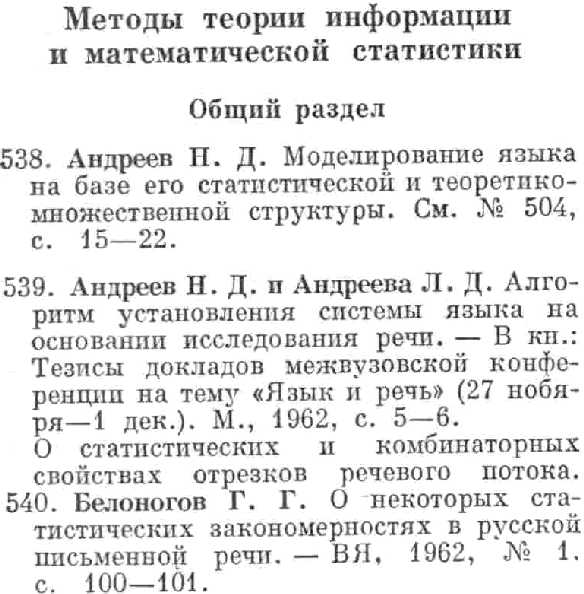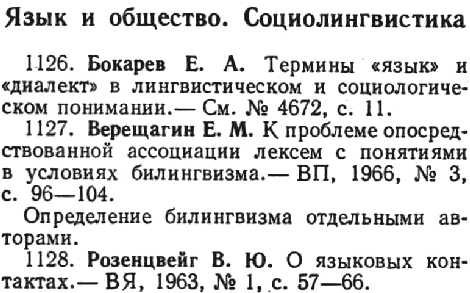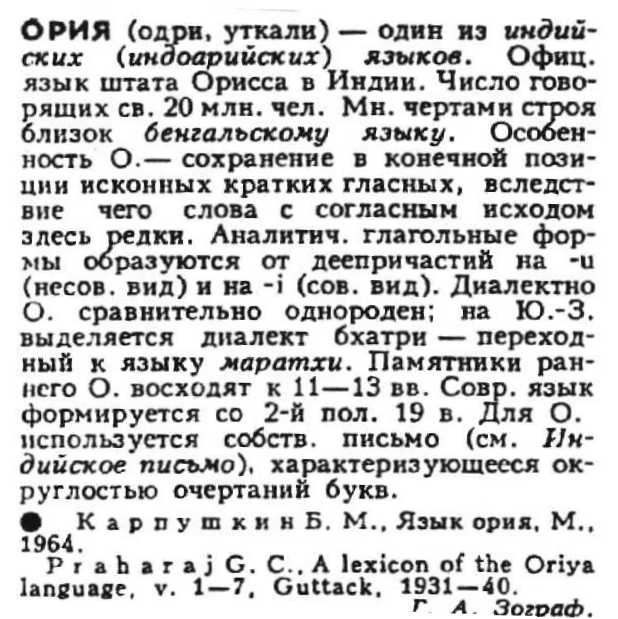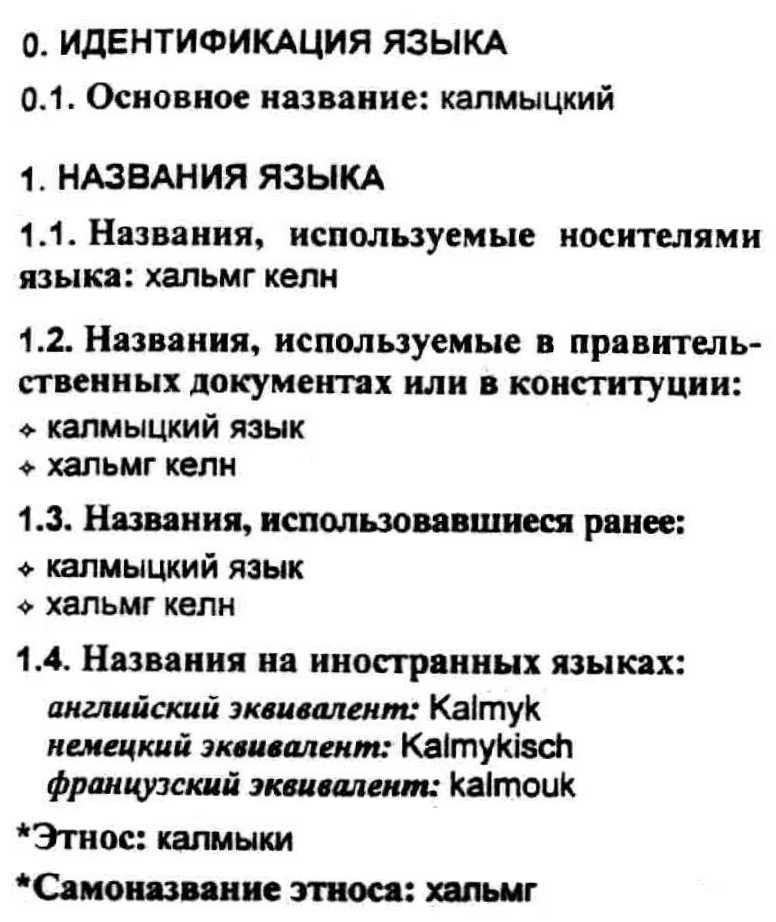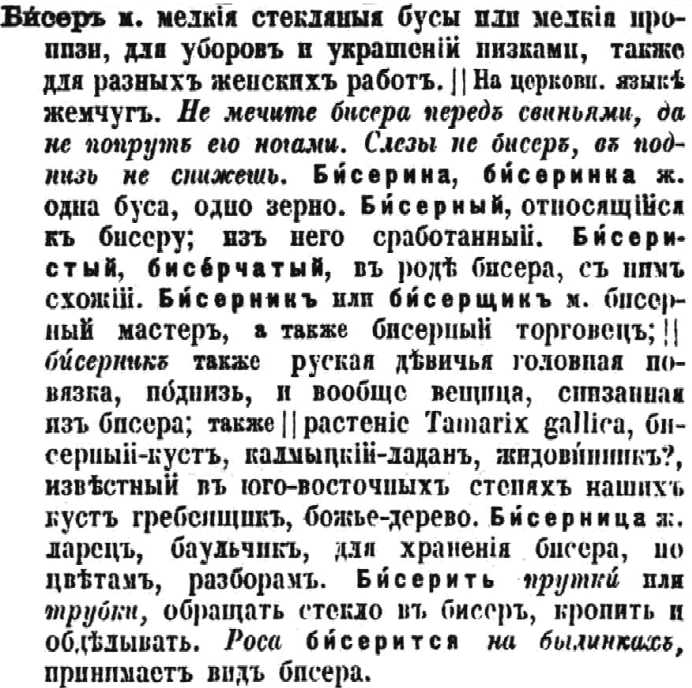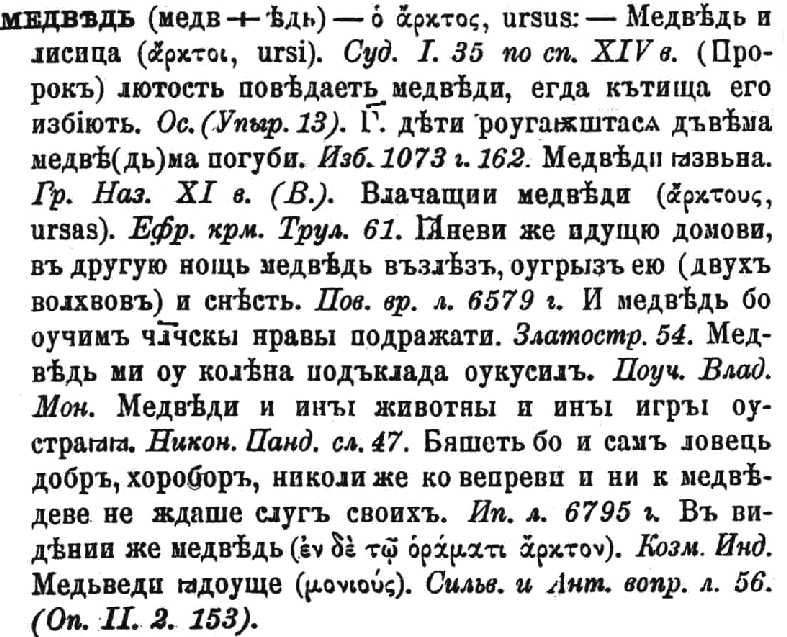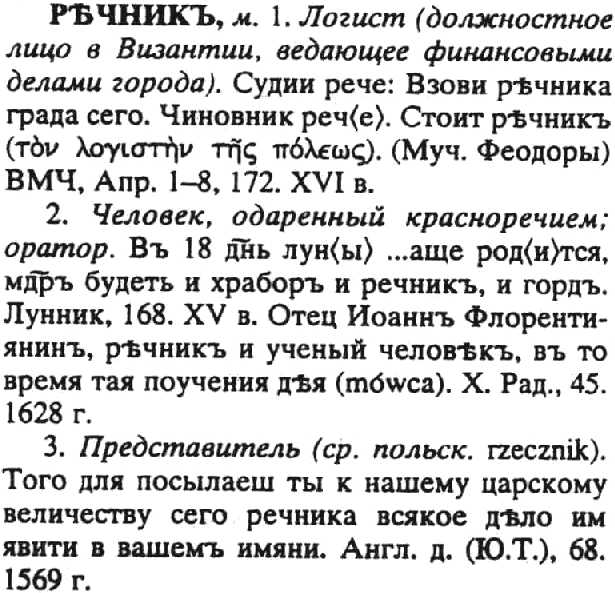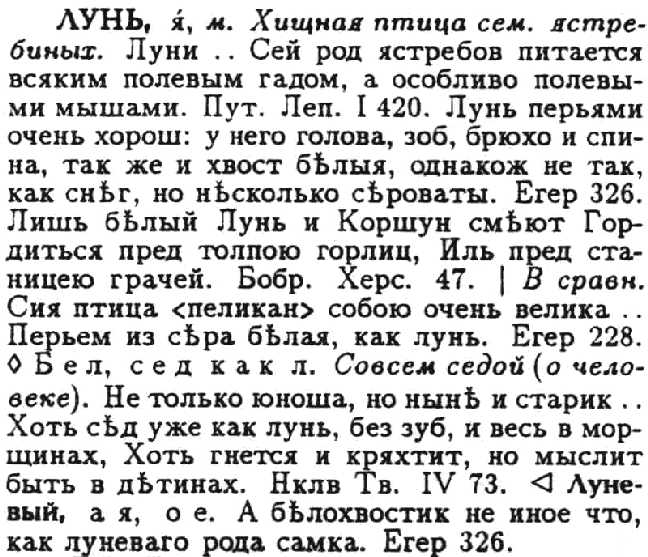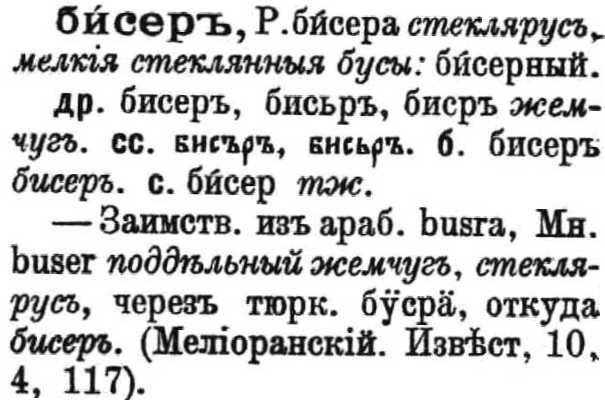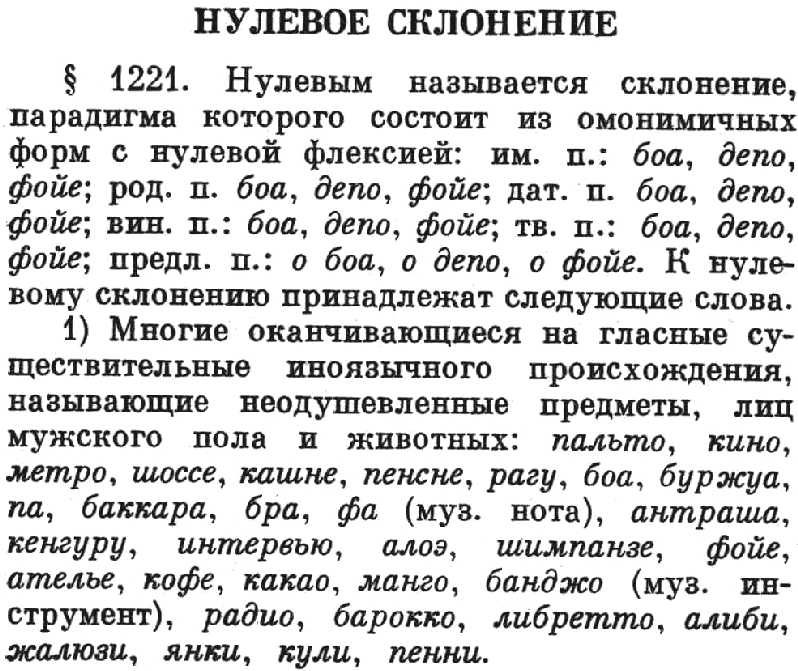
Resources found on this page include works about Russian language and linguistics regardless of the language of publication and works about linguistics in general that are published in the Russian language. Resources about Slavic linguistics or other Slavic languages that are published in the Russian language will appear on the pages devoted to the individual languages or the General Resources for Slavic Linguistics page. Cross references are provided for works that could be listed under multiple categories. As is true for all of the pages in this course, clicking on either portraits or names of bibliographers and authors will lead to their biographical data. Sources about Russian personal and geographic names are not included in the linguistics sections of this course, but many of the bibliographies described below will present material of interest in the field of onomastics.
Keep in mind some of the general bibliographic resources for Russian that are annotated in other sections of this course, for they often provide the most comprehensive and most current lists of citations of Russian publications, including those in the field of linguistics. For example, Ezhegodnik knigi, now called Knigi Rossiiskoi Federatsii: ezhegodnik, which has been published since 1911 and is still being published, has a section every year on Russian monographs about linguistics. The serial Bibliografiia Rossiiskoi bibliografii, which has been published since 1939 and is still being published, also contains a section devoted to linguistics. Check it for the most current published bibliographies emanating from Russia.
Guides
Bibliografiia bibliografii po iazykoznaniiu. Annotirovannyi sistematicheskii ukazatel’ otechestvennykh izdanii.
Moskva: Gosudarstvennaia ordena Lenina Biblioteka SSSR im. V. I. Lenina, 1963. 411 p.
U of I Library Call Number: International & Area Studies Russian Reference (Slavic) and Main Stacks 016.4 M85b
This a comprehensive annotated listing of all linguistics bibliographies published in Russia/Soviet Union up to the 1950s, including bibliographies published as separate monographs, at the back of books, or in articles. While it only includes bibliographical materials in the body of the book, there are some very useful supplementary sections that will assist the scholar in a study of retrospective linguistic work. The supplementary materials include a bibliography of the publications of academic institutions, including library catalogs; an index of indexes for periodical publications, foreign and Soviet; a bibliography of dissertations and a list of the bibliographic materials not included in the index. There is also a large section on the works of individual linguists.The book is divided into three parts: general works; languages of the world, arranged by linguistic group; and supplements. There are two indexes: an index of names and titles and and index of languages. See the entries below which appear in the Lithuanian section.
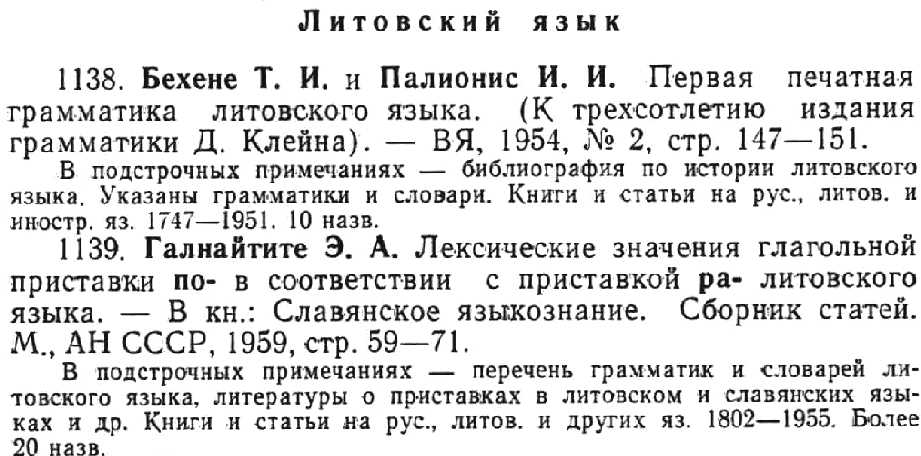
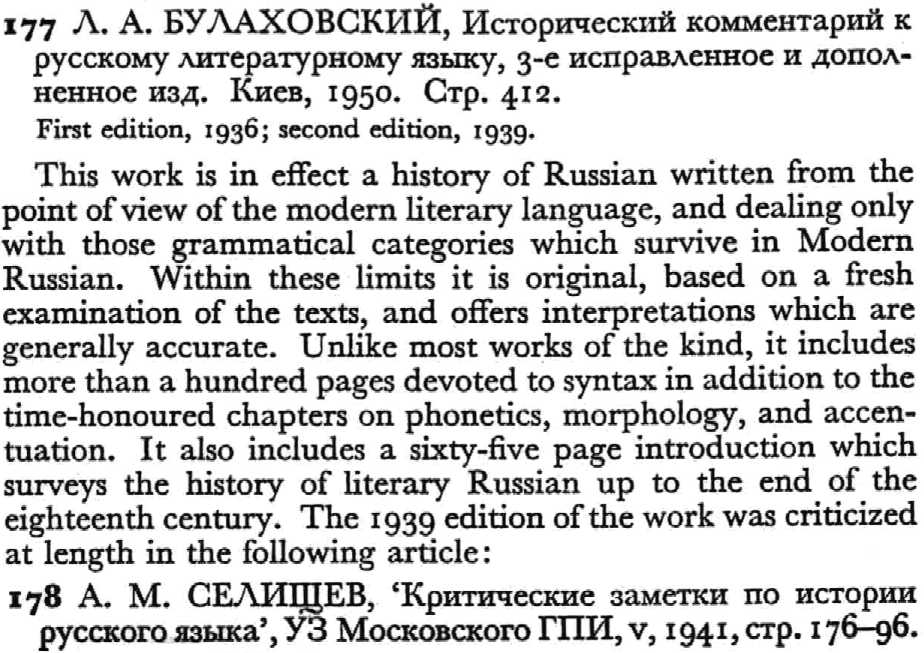
A Bibliographical Guide to the Russian Language
Unbegaun, B.O. Oxford: Clarendon Press, 1953. 174 p.
U of I Library Call Number: International & Area Studies Russian Reference (Slavic) and Main Stacks A.491.7 Un1b
This is a selected annotated bibliography for works on the Russian language compiled by the eminent linguist B.O. Unbegaun. Although it was published almost 50 years ago and thus is quite incomplete, it still presents some of the classic works in the field annotated by a renowned expert. it is divided into several sections: general, historical, descriptive with many further subdivisions such as periodicals, texts and paleography, history of the literary language, etc. Often at the beginning of a section Unbegaun makes a few statements on the state of the research in that area before he annotates sources. There is an index of authors. See his entry to the right for Bulakhovskii’s work which appears on page 31.
Bibliographies for Russian Linguistics
Be sure to look at the General Resources for Slavic Linguistics page, because many of the items there will be pertinent for the study of Russian. In particular, note Slavianskoe iazykoznanie, which is largely about Russian and East Slavic.
Bibliograficheskii ukazatel’ literatury po russkomu iazykoznaniiu s 1825 po 1880 god.
Vinogradov, V.V., ed. Moskva: Izd-vo Akademii nauk SSSR, 1954-1959. 8 vols.
U of I Library Call Number: Oak Street Facility 016.4917 Ak12b v.1-8. This source is also available as an electronic resource through our catalog. Please follow this link.
Compiled by scholars at the Academy of Sciences, this wonderful annotated bibliography of works on Russian linguistics from 1825 to 1880 consists of 7 parts plus an index volume: 1) the Russian literary language, grammar, word-formation, phonetics, orthoepy, orthography, punctuation, script, 2) Lexicology and lexicography, 3) Historical grammar, dialectology, the language of folklore, Old Church Slavic, 4) History of the Russian literary language, stylistics and the culture of speech, 5) Pamiatniki russkogo iazyka 6) Textbooks and methodological literature, 7) Ukrainian and Belorussian, comparative linguistics, historiography of Russian linguistics. Each of these sections is further divided into 2 parts, Books and Articles/Reviews. The Books section is organized alphabetically by author or title and the Articles/Reviews section is organized by broad subject category. Volume 1 contains the list of periodical sources used to compile the Articles/Reviews section as well as a small pseudonym dictionary. Volume 8 contains the index of authors and titles. This work could be of interest to any Slavic linguist since it includes in addition to Russian, citations for Belorussian, Ukrainian, and comparative Slavic as well. See the entry below for an item by N. Skandovskii. Note the citation for a review of Skandovskii’s work that appears at the end of the annotation.
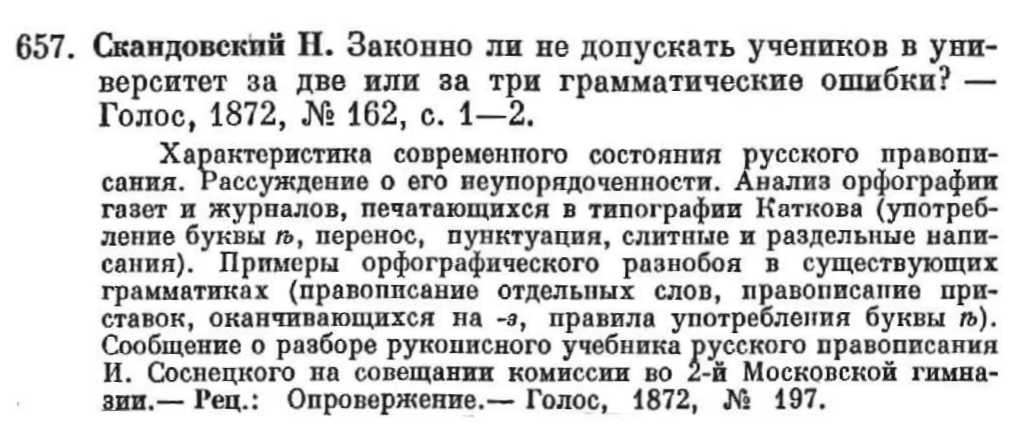
Novaia literatura po sotsial’nym i gumanitarnym naukam. Iazykoznanie + Novaia otechestvennaia literatura po obshchestvennym naukam. Iazykoznanie + Novaia sovetskaia literatura po obshchestvennym naukam. Iazykoznanie.
Moskva: INION RAN, 1954 –
U of I Library Call Number: International & Area Studies Russian Reference (Slavic) Q.016.405 NOV11 [Current issues and previous year] + Main Stacks [1993-1999] + 016.405 NOV1 [1992] + 016.405 NOV [1967-1991] [U of I lacks 1954-1966]
Also available online. See RAS Bibliographics.
Compiled by INION, the social sciences branch of the Russian Academy of Sciences, this serial bibliography has been in publication since 1954, albeit under several different titles. It includes citations for articles and books on all topics related to linguistics with sections from general and theoretical topics to those devoted to individual languages of the world. Although many of the sources are Russian and East European language journals, this bibliography also indexes some western language titles. Those citations are given in their own language, rather than in Russian translation. There are author and subject indexes for each issue as well as lists of publications consulted in the compilation of the bibliography. This title is also available online as part of the Russian Academy of Sciences Bibliographic subscription database. See the citations below that appeared in the 2001, no.11 issue under the heading West Germanic Languages.
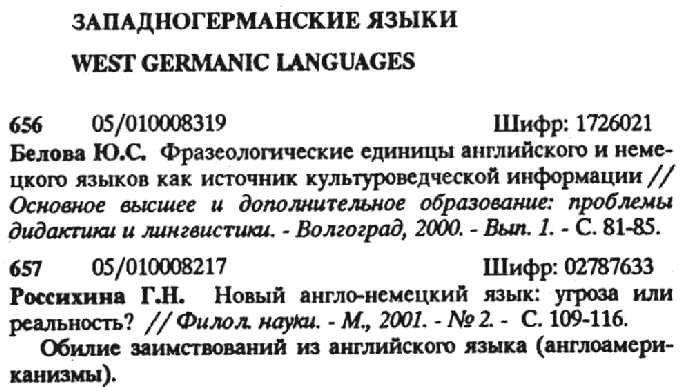
A Bibliography of Russian Word-Formation
Worth, Dean S. Columbus, OH: Slavica, 1977. 317 p.
U of I Library Call Number: International & Area Studies Russian Reference (Slavic) 016.49172 W89b
With over 3000 citations for articles and books published before 1974, this work presents in the author’s words “a typology of topics in Russian derivation.” The book is divided into several sections including General and theoretical works, morphology, derivational types and models, semantics of derivation, derivation of and from parts of speech, dialect studies, and foreign influences. Use the detailed table of contents to navigate through the many subdivisions in the basic organization. What is particularly nice about this bibliography is the organization of citations based on individual prefixes and suffixes. For example, if you want to read more about adjectival suffixation in Russian, the section begins with items on the topic in general and then subdivides the citations by individual adjectival suffix, so you can find articles that treat the suffix -ichesk- or others on the suffix -n- or -nn-. Citations are presented in transliteration and there is an author index at the back. See the entries below which appear for the suffix -n- / -nn-.

Sotsial’nye i gumanitarnye nauki. Otechestvennaia i zarubezhnaia literatura. Seriia 6. Iazykoznanie.
Moskva: INION RAN, 1973-
U of I Library Call Number: Main Stacks 405 OB11 + 405 OB 1975-2001. Current issues in International & Area Studies Slavic Serials.
Although this source is not in essence a bibliography, it does present current monographic publications on Russian and world linguistics. It is subtitled “referativnyi zhurnal” which means that it provides abstracts of publications. Abstracts are written by the editors of the journal who are Russian scholars of philology. This source is an excellent way to keep current in the field for people who read Russian since all of the abstracts appear in Russian regardless of the original language of the reviewed publication. Abstracts are arranged by general subjects such as sociolinguistics, syntax, dialectology, etc. Many of them resemble review articles rather than abstracts. There are indexes in every issue for authors and titles and for subjects.The journal has changed title several times since it began in 1973, but only the current title is given above.
Russian Bibliographies on Assorted Topics in Linguistics
Strukturnoe i prikladnoe iazykoznanie. Bibliograficheskii ukazatel’ literatury, izdannoi v SSSR s 1918 po 1962 g.
Moskva: Nauka, 1965. 193 p.
U of I Library Call Number: International & Area Studies Russian Reference (Slavic) and Oak Street Facility 016.4 Ak13s
Covering almost 50 years of Soviet scholarship on structural and applied linguistics, this bibliography contains citations for works published in all languages of the Soviet Union. The citations, however, have been translated into Russian and a language designation appears at the end of the entry. E.g. Na uzb. iaz. for an article published in Uzbek. Works included are books, articles and anthologies, with complete contents given for every anthology. Citations for reviews of books appear at the end of an entry. The citations are organized by subjects such as structural and mathematical methods of linguistics, with subsections like morphology and phonetics or applied linguistics with subsections on automatic translation and artificial languages. Use the table of contents to locate topics of interest. There is an index for names and titles. See the entries on the left for some works that appear under the heading Methods of the theory of information and mathematical statistics.
Obshchee iazykoznanie. Bibliograficheskii ukazatel’ literatury, izdannoi v SSSR s 1918 po 1962 g.
Moskva: Nauka, 1965. 275 p.
U of I Library Call Number: International & Area Studies Russian Reference (Slavic) and Main Stacks 016.4 Ak13o
Covering almost 50 years of Soviet scholarship on general topics in linguistics, this bibliography contains citations for works published in all languages of the Soviet Union. The citations, however, have been translated into Russian and a language designation appears at the end of the entry. E.g. Na gruz. iaz. for an article published in Georgian. Works included are books, articles and anthologies, with complete contents given for every anthology. Citations for reviews of books appear at the end of an entry. The citations are organized by subjects such as methods and means of linguistic research, with subsections like the comparative-historical method and statistical methods, or language and society, with subsections on the literary language and dialects. Use the table of contents to locate topics of interest. There is an index for names and titles. See the entries above for some works that appear under the heading Egyptian hieroglyphics.
Obshchee i prikladnoe iazykoznanie. Ukazatel’ literatury, izdannoi v SSSR s 1963 po 1967 god. + 1968-1977 gg.
Moskva: Nauka, 1972. 295 p. + Moskva: INION, 1981.
U of I Library Call Number: International & Area Studies Russian Reference (Slavic) 016.41 M29o (1968-1977)
This source combines and continues the content of the two bibliographies described above, for it covers both general and applied linguistics for the next 5-year period, 1963-1967. It follows a similar content plan with citations for articles, books, reviews, and complete contents of anthologies. Citations for works in the languages of the Soviet Union are translated into Russian with a language designation at the end. For example, Na arm. iaz . for works published in Armenian.The subject arrangement is somewhat different than the two above, but the table of contents indicates the subdivisions such as Language and speech, semantics, transcription, stylistics, etc. There is an appendix that cites a few reviews of books that appeared before 1963, but were not included in one of the two previous bibliographies. There are a subject index, a person index, and a name and title index as well. This volume was continued with another publication of the same title that covers the years 1968-1977. See the image above for some citations that appear under the section Language and Society. Sociolinguistics from the 1963-1967 volume.
Russkaia avtorskaia leksikografiia XIX-XX vekov : antologiia
Karaulov, Iu. N. Moskva, Azbukovnik, 2003. (Available online here.)
U of I Library Call Number: Main Stacks, 491.709 R9213
The works listed herein focus on the period between 1883 and 2001, and they center on the theory and practice of authorial lexicography. The works listed are in both Russian and other languages. The bibliography is divided into two sections: “Dictionaries,” which features a list of dictionaries and other similar materials, and “Literature,” which features a list of works such as monographs, dissertations, and articles.
Russkaia emigratsiia o russkom iazike : annot. bibliogr. ukaz. (1918-1992)
Granovskaia, L. M. Moskva: Az”, 1993.
U of I Library Call Number: History, Philosophy, and Newspaper Library, FILM 491.7 G766r
This publication includes studies, articles, notes, reviews, diary entries, and other fragments; mostly extractions from literary speech about the language. Entries include annotations and abstracts.
Periodical Indexes for Russian Linguistics
Several of the titles annotated above in the Bibliographies section and below in the Russistika section could be listed under Periodical Indexes as well since they extract data from numerous linguistics journals. See in particular Novaia literatura po sotsial’nym i gumanitarnym naukam. Iazykoznanie. Of course, the primary source for finding articles printed in Russian journals is still Letopis’ zhurnal’nykh statei which has been published since 1926. It has a section for iazykoznanie.
Russistika
Under this heading can be found several bibliographies that cover Russistika produced by scholars in various Eastern European countries. Many of the citations are for linguistic items and items about teaching Russian, but Russistika covers Russian literature and culture as well. If there are Russistika bibliographies that publish separate volumes for each subject, linguistics and literature, only the linguistics volumes will be discussed below. Publications of Russistika often are cataloged with the subject heading “Russian philology.” Try searching WorldCat using that heading or keywords such as “russistika” or “rusistika” to find other works in this category.
Rusistika v GDR. Bibliograficheskii ukazatel’ literatury po iazykoznaniiu, literaturovedeniiu i metodike obucheniia russkomu iazyku 1967-1977 gg.
Brandt, Bertolt, ed. Berlin: Volk und Wissen, 1979. 338 p.
U of I Library Call Number: International & Area Studies Russian Reference (Slavic) 016.4917 M579r
With more than 5000 citations on language and literature, this bibliography covers the scholarly ouput of East German Russian specialists from 1967-1977 regardless of country of publication. Also included are the works of non-German scholars who published while working in the DDR. The languages of most of the works cited are German and Russian. The citations are arranged into 7 sections such as Russian as a world language, linguistics, literature, personalia and bibliographies, among others. There are author and subject indexes. See the entries below that appear under the linguistics section.

Bibliographie der in den Wissenschaftlichen Zeitschriften der Universitaten und Hochschulen der DDR veroffentlichen. Beitrage zur Russistik. Teil 1 1951-1967, Teil 2 1968-1973.
Wendt, Ch. ed, et al. Greifswald: Ernst-Moritz-Arndt-Universitat Greifswald, 1978-1979. 2 vols.
U of I Library Call Number: International & Area Studies Russian Reference (Slavic) 016.4917 W48b v.1-2
Similar to the volume above, this bibliography covers scholarship on Russian language and literature from DDR from 1951-1973. The difference is that this work includes citations only from periodicals published by institutions of higher education in DDR. The list of journals is given on p.5 of each volume. The language of the works cited is German. Citations are arranged by broad subject category such as linguistics, literature, reviews, etc. There are author indexes for both volumes. See the entries below that appear under the linguistics section.

Bibliografia rusycystyki polskiej 1945-1975. Jezykoznawstwo.
Jurkowski, Marian. Warszawa: Panstwowe wydawnictwo naukowe, 1976. 172 p.
U of I Library Call Number: International & Area Studies Russian Reference (Slavic) 016.4917 J97b
This bibliography provides more than 1700 citations for works by Polish scholars of Russian linguistics. The material is organized into 3 sections: publications by Polish authors in Poland, foreign publications by Polish authors, and Polish publications by foreign authors. Within each section the citations are arranged chronologically. Citations for reviews are included under entries for books if available. There is an author index, but unfortunately, no subject index or arrangement. See the entries below which appear in the section for publications by Polish authors in Poland.

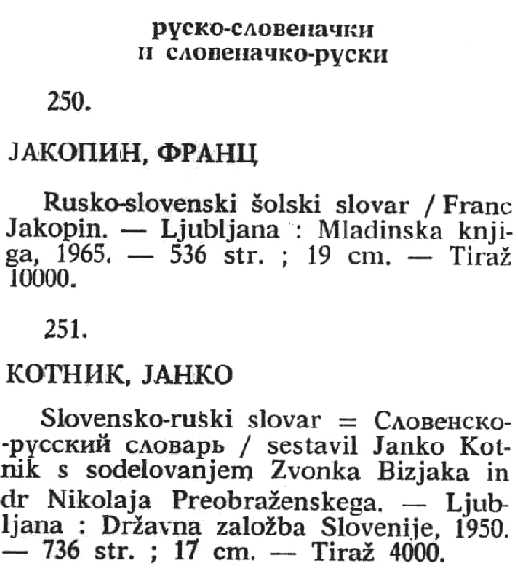
Bibliografija jugoslovenske lingvisticke rusistike (1945-1975).
Piper, Predrag. Novi Sad: Matica srpska, 1984. 247 p.
U of I Library Call Number: International & Area Studies Russian Reference (Slavic) 016.4917 P661b
The goal of this bibliography was to record all the works published in Yugoslavia about Russian and all the works published abroad about Russian by Yugoslav scholars for the given time frame. Almost 2000 entries are included. Entries are arranged by subject, for example, the history of Russian, intonation, versification, and bilingual dictionaries, among others. Use the table of contents to narrow down the sections of interest. There are several indexes to aid the user such as author, title, and chronological. See some of the entries on the left that appear under the heading Russian-Slovene dictionaries.
Bibliografiia chekhoslovatskoi rusistiki 1971-1980.
Praga: Gosud. Pedagogicheskoe izd-vo, 1982. 503 p.
U of I Library Call Number: Oak Street Facility 016.4917 M579b
This bibliography of Rusistika from Czechoslovakia follows a similar arrangement of material to others of its kind with sections for linguistics, literature, and teaching Russian. Within each section the entries are arranged alphabetically by author. It contains over 8000 citations for books, articles, dictionaries, and reviews by Czech or Slovak scholars of Russian published on the territory of Czechoslovakia or abroad. Dissertations are excluded from this compilation. There is an author index. See the entries below which appear in the section for teaching Russian.

Iazikoznanie v Bashkortostane : Rusistika : bibliogr. ykaz. opubl. Iazikovedami-rusistami Bashkortostana s 1954 po 1998 gg.
Gaisina, R. M.; Samokhina, L. A. Yfa: Bashkirskii gosudarstvennii universitet (bez izdatel’stva), 1999. (Unavailable at the University of Illinois, but you can find the WorldCat record here.)
This bibliography focuses on linguistics in Bashkortostan. It features monographs, textbooks, teaching aids, dictionaries, articles, and conference presentations. It also features some abstracts for doctoral dissertations and theses, as well as info on periodicals and scientific publications. Topics include traditional Russian linguistics, as well as theoretical linguistics, theoretical and educational lexicography, theory of spoken language, textual linguistics, linguistics geography, socio-linguistics, psychological linguistics, rhetoric, theory of speech acts, and comparative linguistics. The 2844 sources are organized alphabetically.
Encyclopedias
Iazykoznanie. Bol’shoi entsiklopedicheskii slovar’.
Iartseva, V.N. , ed. Moskva: Bol’shaia Rossiiskaia entsiklopediia, 1998. 2-e (reprintnoe izdanie “Lingvisticheskogo entsiklopedicheskogo slovaria” 1990 goda). 682 p.
U of I Library Call Number: International & Area Studies Russian Reference (Slavic) 410 Ia9223 1998
Compiled by eminent Russian philologists, this scholarly encyclopedia addresses all topics of linguistics in detailed entries complete with bibliographical references. There are entries for individual languages of the world, linguistic terminology, language families, alphabets, trends and concepts. There are no biographical entries, but an annotated name index instead, which provides full names, dates, and page numbers that refer to the places where the individuals are mentioned or cited. Indexes for world languages and terminology complement the main body of the encyclopedia. A nice feature of this work is that terms of foreign derivation give the foreign source of the term as well as other Russian equivalents. Entries range in length from one paragraph to several pages. See the entry for the Oriya language.
Pis’mennye iazyki mira. Iazyki Rossiiskoi Federatsii. Sotsiolingvisticheskaia entsiklopediia. Kniga 1.
Solntsev, V.M. , ed. Moskva: Academia, 2000.
U of I Library Call Number: International & Area Studies Russian Reference (Slavic) 409.47 P675 v.1
Published as part on an international project with Laval University in Quebec, this encyclopedia has detailed sociolinguistic descriptions of 30 written languages of the Russian Federation. Every language entry is comprised of 20 separate sections and is extensive, ranging from 10-20 pages in length and providing the same information in the same numerical format for each. For example, under section 2 in each entry you will find statistical and geographical information taken from the 1989 census. Besides statistical information, there are a list of the various names of the language, a description of the important linguistic features, a discussion of the current status of the language, a list of known specialists and organizations devoted to the study of the language, a list of current periodicals published in the language, and a bibliography, among other things. Before the entries for the languages is a long introduction about studying written languages and the issues involved as well as more statistical information. See the image on the left for section 1 of the Kalmyk language.
Russkii iazyk. Entsiklopediia.
Karaulov, IU.N. ed. Moskva: Bol’shaia Rossiiskaia entsiklopediia, 1997. Izd. 2-e, pererabot. i dopol. 703 p.
U of I Library Call Number: International & Area Studies Russian Reference (Slavic) 491.753 R921784 1997
The second edition of this encyclopedia about the Russian language contains over 700 articles which were written by eminent Russian scholars. With articles on all aspects of the Russian language from parts of speech and stylistic levels to organizations and publications, Russkii iazyk can be a valuable resource for anyone interested in learning about Russian. For example, there are entries for dictionaries of various types which discuss the most important examples for Russian and entries for each letter of the Russian alphabet which discuss derivation and phonemic significance. There are even entries for Russian linguistic phenomena such as polnoglasie . Most articles are signed and have bibliographical references. There are indexes for names and subjects. Numerous illustrations and charts enhance the text. See the entry below for the letter “m”.

Entsiklopedicheskii slovar’-spravochnik lingvisticheskikh terminov i poniatii. Russkii iazik: v 2 t.
Tikhonov, A. N.; Khashimov, R. I.; Zhuravlyova, G. S. Moskva: Flinta: Nauka, 2008. U of I Library Call Number: Main Stacks, 410.3 En874
This dictionary is set up like an encyclopedia and a textbook. The articles are listed alphabetically and thematically, and there are three parts: general linguistic terminology and ideas, the Russian language, and applications. The dictionary centers on terminology of Russian and general linguistics. The encyclopedia portion of the volume also includes articles on the composition and character of the Russian language, touching upon various linguistic topics. The dictionary portion of the encyclopedia features the main word or combination of words, followed by its meaning, illustrative material, and a bibliography.
Iaziki Rossiiskoi Federatsii i sosednikh gosudarstv: Entsiklopediia: v 3 t.
Rossiiskaia Akademiia Nauk, Institut Iazikoznaniia. Moskva: Nauka, 1997-2005. U of I Library Call Number: International and Area Studies Library, 409.47 Ia92
This volume contains 180 essays, of which 150 are about separate languages and 30 are about language groups. The essays are mostly about the history of the language, description of the language families, and their current usage. The essays are listed alphabetically, and the end of each one there’s a bibliography. There’s also an index of idioms, ethnonyms, and names.
Dictionaries
There are literally hundreds of dictionaries for Russian, from dictionaries of the standard language and slang to dictionaries of special subject vocabulary and bi- or multi-lingual ones. For this reason you should consider using one of the bibliographies of Russian or Slavic dictionaries to help you wade through the morass. Information about dictionaries and bibliographies of Slavic dictionaries is given on the general Dictionaries page and the page entitled Sources for Dictionaries and Language Resources. Another source that can be useful for locating Russian dictionaries is Russkii iazyk. Entsiklopediia, because it has articles on various types of dictionaries with the major Russian ones briefly discussed in the articles. We make no attempt to include here the wealth of bilingual, specialized terminological or grammatical dictionaries for Russian. Only a few Russian dictionaries that are considered classic reference sources are listed in the section below.
Slovar’ sovremennogo russkogo literaturnogo iazyka. Tom 1-17.
Slovar’ sovremennogo russkogo iazyka. Izd. 2-oe, pererabot. i dopol. Tom 1-20.
Moskva-Leningrad: Izd-vo Akademii Nauk SSSR, 1950-1965. 17 vols. + Moskva: Russkii iazyk, 1991-
U of I Library Call Number: International & Area Studies Russian Reference (Slavic), Main Stacks, and Oak Street Facility 491.7 Ak1s v.1-17; International & Area Studies Russian Reference 491.7 Ak1s1991 v.1-6 [only 6 volumes published to date]
The 17-volume Russian dictionary from the Academy of Sciences and its second revised edition, of which only 6 volumes have appeared to date, is the standard reference dictionary for the contemporary literary language. The Academy dictionary is a normative dictionary, thus it does not include dialectal words unless they have taken on national significance, clearly obsolete terms that do not appear in works of significant authors, or specific technical terminology, rather its strives to codify the standard or ideal form of the language. Its significance is similar to that of the Oxford English Dictionary in that it defines words and excerpts lines as examples of usage by Russian authors from Pushkin and his time up to the present day. The literary excerpts make this dictionary particular valuable for scholars of Russian literature. For example, if you have a specific term and would like to know not only what it means, but also some literary precedents, you will find that information here. It also includes brief etymologies in the notes sections which begin with a dash and appear at the end of each entry. Also present in the notes sections are references to other dictionaries where the word may be found and other forms of the word as they appear in those dictionaries. See Vasmer’s etymological dictionary for fuller etymologies. The list of literary sources and dictionaries used in the compilation follows the introduction in the first volume of each set with additional source lists appearing in volumes 2 and 3 of the first edition.
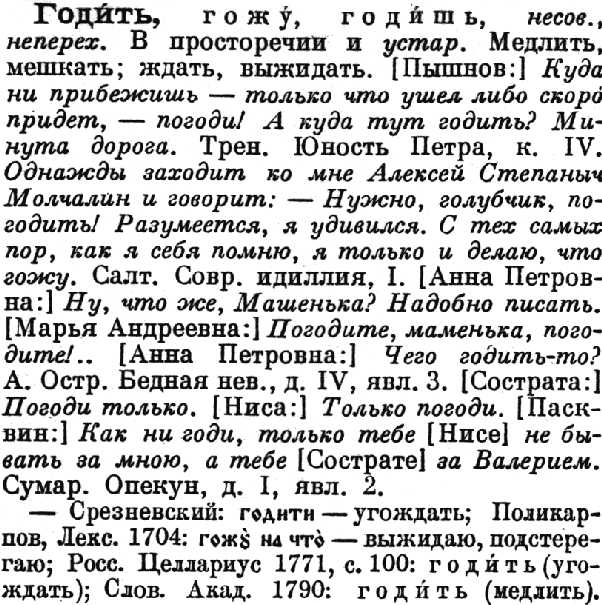
A typical entry begins with the word in bold face, followed by grammatical designations such as part of speech, gender or aspect where applicable, unusual grammatical forms, a stylistic designation if necessary, etc. Accent marks show the pronunciation of the various forms. The definitions follow in regular type face with the literary excerpts appearing in italics. The citations for the literary sources stand out from the excerpts because they also are printed in regular type face. The introduction, arrangement of the parts of the entries, and abbreviation key for terms and authors are provided only in Volume 1 of each set. See the entry from the first edition for the verb godit’ which shows lines from Trenev, Saltykov-Shchedrin, A.N. Ostrovsky, and Sumarokov.

Tolkovyi slovar’ zhivogo velikorusskogo iazyka v chetyrekh tomakh.
Dal’, V. I. Moskva: “Progress,” “Univers,” 1994. Reprint of the 1903-1909 edition of Baudouin de Courtenay. 4 vols.
U of I Library Call Number: International and Area Studies Russian Reference (Slavic) 491.7 D15t 1994 v.1-4
HathiTrust full-text links:
vol. 1: http://hdl.handle.net/2027/mdp.39015030391695
vol. 2: http://hdl.handle.net/2027/mdp.39015030391687
vol. 3: http://hdl.handle.net/2027/mdp.39015030391679
vol. 4: http://hdl.handle.net/2027/mdp.39015030391653
Considered by all Slavic linguists to be a great achievment in the history of the Russian language, this dictionary was originally published in 1863-1866. The compiler was the eminent Vladimir Ivanovich Dal’ who also compiled the classic dictionary of Russian proverbs and sayings which is annotated elsewhere in this course. According to the definition given in Russkii iazyk. Entsiklopediia, a tolkovyi slovar’ is an explanatory dictionary, it gives definitions of words and phrases of a particular language using the words of the language itself. A tolkovyi slovar’ also often provides details about grammatical peculiarities, stress, stylistics, and some common phrases that use the word under discussion. In fact, Dal’ provides all of this information plus a number of proverbs and idioms. It covers about 200,000 words from 19th century Russian, some dialectal, some coined by Dal’, and many related to various trades. The words are arranged alphabetically by etymological and derivational groups. For example, see the entry on the right for the word biser which shows not only biser, but related nouns, adjectives and verbs as well.
Although there have been several editions of the Tolkovyi slovar’ and the University of Illinois holds most of them in its collection, the edition noted here is a reprint of the one revised by Baudouin de Courtenay. There is also an online version of Dal’s Tolkovyi slovar’ that is available for free on the Internet. For more detailed annotations of this important dictionary, see Stankiewicz, pp.143-44 and Kaufman, pp.23-24. Kaufman also provides bibliographical references for further reading about Dal’ and his dictionary.

Materialy dlia slovaria drevne-russkago iazyka po pis’mennym pamiatnikam.
Sreznevskii, I.I. Sankt-Peterburg: Tip. Imp. Akademii Nauk, 1890-1912.
U of I Library Call Number: Main Stacks and Oak Street Facility Q.491.7 Sr2m 1958 v.1-3 and 491.7701 Sr22s 1989 v.1:1-3:2
HathiTrust full-text link for vol. 1 : http://hdl.handle.net/2027/mdp.39015085546623
and
Indeks a tergo do materialow do slownika jezyka staroruskiego I.I. Srezniewskiego.
Warszawa: PWN, 1968. 385 p.
U of I Library Call Number: International & Area Studies Russian Reference (Slavic) 491.7 Sr2m index
Compiled by the famous Russian linguist I. I. Sreznevskii, this dictionary is an important resource for the study of the history of Russian. It extracts words and passages from 2700 Old Russian written sources from the 11th through the 14th centuries. Entries appear in alphabetical order and most include modern Russian, Latin, and Greek equivalents as well as passages from Old Russian documents that illustrate usage. Indexes of the sources used are listed at the end of volumes 1 and 3. See the entry for medved’ shown on the left. The call numbers given above are for two different reprint editions of this classic pre-revolutionary dictionary and a reverse index that was produced by scholars at the Polish Academy of Sciences. The reverse index allows one to locate words that have the same derivational suffixes.

Slovar’ russkikh narodnykh govorov.
Filin, F.P., ed. Moskva-Leningrad: Nauka, 1965-
U of I Library Call Number: Main Stacks 491.73 Ak12s v.1-35 [letters A-Riashchik]
Reverse Index to the Dictionary of Russian Dialects. Preliminary Version, vols.1-25.
Gladney, Frank. Urbana, IL: Department of Slavic Languages and Literatures, University of Illinois, 1991. 565 p.
U of I Library Call Number: International & Area Studies Russian Reference (Slavic) 491.73 Ak12s Index
Inversionnyi indeks k Slovariu russkikh narodnykh govorov.
Sorokoletov, F.P. et al. Sankt-Peterburg: Izd-vo S.-Peterburgskogo universiteta, 2000. 607 p.
U of I Library Call Number: International & Area Studies Russian Reference (Slavic) Q.491.73 Ak12s index1
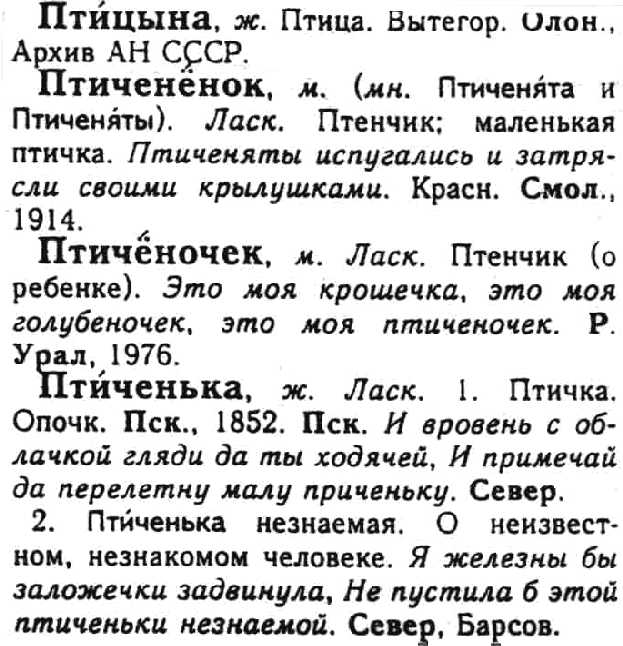
Although this dictionary is still being published, the volumes that have appeared to date comprise a valuable resource for anyone interested in Russian dialectology. It attempts to compile a dialectal lexicon and phraseology for Russian for the 19th and 20th centuries. Entries supply grammatical information relevant to the part of speech of a word, a definition in standard Russian, stress, and citations for sources and dialects. Some entries excerpt passages to show usage. A list of geographical abbreviations is provided to help interpret in which dialectal area a particular term is found. An extensive bibliography of sources consulted for the compilation of the dictionary is included in the first volume with bibliographies of additional sources appearing at the beginning of various subsequent volumes. Sources include published materials and manuscripts. See the image on the right for several entries showing diminutives of the noun ptitsa.
Intended as an “aid to the study of Russian morphology” according to its introduction, the reverse index presents over 130,000 words that appear in the first 25 volumes of Slovar’ russkikh narodnykh govorov in reverse alphabetical order. This enables the user to locate words formed by the same derivational suffixes. Diacritics to show place of stress are included. A more recent version of the reverse index covering approximately 240,000 words was published in 2000. See the article in Russkii iazyk. Entsiklopediia, pp. 179-180, for more information on the kartoteka that was created to aid in the compilation of this dictionary and that is still being added to today by scholars at the Academy of Sciences in Saint Petersburg.

Opyt oblastnago velikorusskago slovaria. + Dopolnenie.
Sankt-Peterburg: Imperatorskaia Akademiia Nauk, 1852, 1858. 275 p. + 328 p.
U of I Library Call Number: International & Area Studies Russian Reference Q.491.73 Ak13o, Q.491.73 Ak13o sup.
HathiTrust full-text link : http://hdl.handle.net/2027/mdp.39015085546706
The famous Russian linguist I. I. Sreznevskii participated in the compilation of this first significant dialectal dictionary of Russian. The dictionary includes more than 18,000 words and phrases gathered from dialects in 30 different gubernii . The supplement provides an additional 23,000 words from the same geographic areas. Entries are fairly brief providing some grammatical information, a definition in standard Russian, and an indication of which dialect uses the word. There is a list of sources, many unpublished, divided by guberniia in the original volume. See the image below for two entries related to the word ptitsa.


Slovar’ russkago iazyka.
Sankt-Peterburg: Tip. Imperatorskoi Akademii Nauk, 1895-1929, 1929-1937
U of I Library Call Number: International & Area Studies Russian Reference (Slavic) and Main Stacks 491.73 Ak134s 1984 v.1-8, sup. v.1-4
These volumes are reprints of the Academy dictionary begun by IA. K. Grot in 1886 and continued by A. A. Shakhmatov after Grot’s death in 1893. Although the dictionary was never completed (it ended with the word nedorubshchik), the initial volumes are still a monument of Russian lexicography. The Academy dictionary began a new and enlarged edition in 1929, but it too was not finished. It ended with the word obratnost’. The reprint shows via the color of the covers and the enumeration which volumes were published before 1929 (green) and which were published after (red). The significance of this classic Russian dictionary is that it covered the modern literary and business language of Russia since the time of Lomonosov, including specialized scientific and technical terms. In addition to a number of linguists, famous Russian scientists and scholars such as V.I. Vernadskii and A. F. Koni, among others, consulted in the compilation. For a more detailed annotation of this source as well as citations to other works about it and its compilers, see Kaufman, pp.19-22. Russkii iazyk. Entsiklopediia (pp.178-179) also has an entry for the kartoteka that was created in 1886 to aid in the compilation of the dictionary and which is still in use today in Saint Petersburg.
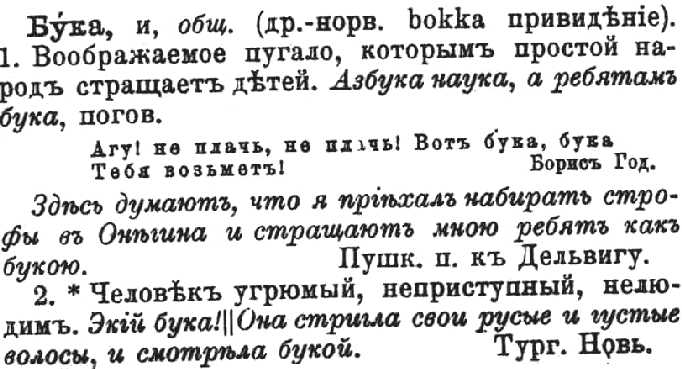
Entries include grammatical and etymological information, definitions, and passages from Russian literature and other writings that illustrate usage. See the entry above for buka which appears in volume 1 (1895). Note the passages from Pushkin and Turgenev.

Slovar’ russkogo iazyka XI-XVII vv.
Akademiia Nauk SSSR. Institut russkogo iazyka. Moskva: Izd-vo “Nauka”, 1975-.
U of I Library Call Number: International & Area Studies Russian Reference (Slavic) 491.770103 Sl58 v.1-29 [U of I lacks v.18, the 1984 Ukazatel’ istochnikov]
Slovar’ russkogo iazyka XI-XVII vv. Ukazatel’ istochnikov v poriadke alfavita sokrashchennykh oboznachenii.
Gekker, S.F. Moskva: Nauka, 1975. 126 p.
U of I Library Call Number: International & Area Studies Russian Reference (Slavic) 491.770103 Sl58sup.
and
Slovar’ russkogo iazyka XI-XVII vv. Spravochnyi vypusk.
Moskva: Nauka, 2001. 813 p.
U of I Library Call Number: International & Area Studies Russian Reference (Slavic) 491.73028 Sl581
Produced by the Academy of Sciences, this dictionary of Russian from the 11th through the 17th centuries contains more than 60,000 words so far with only volumes 1-25 having been published to date (covering letters A-Sn). Entries include grammatical details, a definition in modern Russian, often some derivational information, and passages which show usage. Passages are cited as to source and date. Three separate indexes of sources have been published to accompany the set. This dictionary was compiled using the same kartoteka (but greatly expanded) that was begun by I. I. Sreznevskii for his Materialy dlia slovaria drevne-russkago iazyka po pis’mennym pamiatnikam. For an entry on the kartoteka itself see Russkii iazyk. Entsiklopediia (pp.176-177). See also the 2001 Spravochnyi vypusk which has an article on the history of the kartoteka, a biographical component for all of the contributors to the dictionary, yet another list of sources, and a reverse dictionary. See the entry above right for the word riechnik.

Slovar’ russkogo iazyka XVIII veka.
Barkhudarov, S.G. ed. Akademiia nauk SSSR. Leningrad: Nauka, 1984-
U of I Library Call Number: International & Area Studies Russian Reference (Slavic) and Main Stacks 491.781 Sl585 v.1-20
Slovar’ russkogo iazyka XVIII veka. Pravila pol’zovaniia slovarem. Ukazatel’ istochnikov.
Kutina, L.L. ed. Leningrad: Nauka, 1984.
U of I Library Call Number: International & Area Studies Russian Reference (Slavic) 491.781 Sl585 Sup.A
Like the dictionary described above, this one also is being released over a span of years by the Academy of Sciences. It presents the lexicon of 18th century Russian as extracted from literary, scholarly, scientific, business, and memoir sources, as well as newspapers, journals and other types of documents. Entries include grammatical details, a definition, and passages with sources cited to show usage. Like the other major Russian dictionary projects, this one too used a kartoteka as its base. Russkii iazyk. Entsiklopediia (p. 178) has an entry with information about the kartoteka which is currently located at the Academy of Sciences in Saint Petersburg. See the entry above left for the word lun’ . One of the editors of the dictionary, Iu. S. Sorokin, also edited a separate volume about the dictionary and the methodology of compilation entitled Slovar’ russkogo iazyka XVIII veka: proekt. See U of I Library Call Number Main Stacks 491.73 SL5834.

Obratnyi slovar’ russkogo iazyka.
Moskva: Izd-vo “Sovetskaia entsiklopediia”, 1974. 944 p.
U of I Library Call Number: International & Area Studies Russian Reference (Slavic) , Main Stacks, and Oak Street Facility 491.73 Ob6
Reverse dictionaries are useful tools for both poets and linguists. They present the words of a language in reverse alphabetical order so the user can find words that rhyme or, more importantly, words that are formed by the same derivational suffixes. This Russian reverse dictionary contains approximately 125, 000 words and shows for each word the source that includes that word. Four standard Russian dictionaries are used as sources and they are indicated by means of a letter abbreviation B, M, O, or U. In addition, the part of speech, gender, or aspect of a word is indicated also by an abbreviation. There are several interesting appendices at the end including statistical tables showing the frequency of words ending in a particular letter. A short bibliography of other reverse dictionaries is part of the prefatory materials. See the image below for some words ending in -sha.

Slovar’ russkoi lingvisticheskoi terminologii
Abregov, A. N. Adygeiskii gosudarstvennii universitet, Maikop: Kachestvo, 2003. (Unavailable at the University of Illinois, but you can view the WorldCat record here.)
Contains 2400 Russian terms from linguistics and related disciplines.

Slovar’ russkikh slovarei
Lesnikov, S. V. Moskva: Azbukovnik, 2002.
Unavailable at the University of Illinois library, but you can see the WorldCat record here.
This volume is essentially a bibliography of Russian dictionaries, mainly from the 20th century. The main part of the volume is the card index, which is divided into two main parts. One part deals with linguistic dictionaries, and the other with dictionaries sorted by different topics. The first section includes information about the dictionaries, such as the kind of information they include about the words listed within. The second section includes information on reference books.
See also Polnyi tserkovno-slavianskii slovar’ which offers a lexicon for Church Slavic and contains many Old Russian forms as well.
Etymological dictionaries
The same suggestions given at the beginning of the Dictionaries section above apply for this category as well. Use one of the bibliographies of dictionaries to find out about other etymological works in Russian.
Etimologicheskii slovar’ russkogo iazyka.
Fasmer, Maks . Edited by B.A. Larin . Moskva: Progress, 1964-1973. 4 vols. Translated from the German by O.N. Trubachev .
U of I Library Call Number: International & Area Studies Russian Reference (Slavic), Main Stacks, and Oak Street Facility 491.7 V443rRt v.1-4
Compiled by the eminent Russian-German Slavist Max Vasmer, this etymological dictionary is an important source for Russian historical linguistics. Although there are several etymological dictionaries for Russian, Vasmer’s is considered to be more complete than the earlier ones. Entries, which are arranged in alphabetical order, include a brief definition given in angle brackets, various related words from other languages with the language of origin indicated and definitions for that language also in angle brackets, indication of first use if known, and citations for the sources used to compile the entry. Besides regular words, there also are entries for verbal stems and prefixes. The source list with abbreviations is at the beginning of the first volume and constitutes a major part of the scholarly apparatus for the entries. Knowing where Vasmer got his information allows the scholar to recheck the original source and draw his or her own conclusions. In volume 4 there is an index of terms by language with page references to the entries in which they appear. See the entry below for the the word biser or “beads.”

Originally published in German, this dictionary has been ably translated into Russian by the scholar O.N. Trubachev. The University of Illinois holds both versions in its collection should you prefer to use the German edition titled Russisches etymologisches Wörterbuch [U of I Library call number Main Stacks and Oak Street Facility 491.7 V443r v.1-3].

Etymological Dictionary of the Russian Language.
Preobrazhensky, A.G. New York: Columbia University Press, 1951. 3 v. in 1.
U of I Library Call Number: International & Area Studies Russian Reference (Slavic), Main Stacks, and Oak Street Facility 491.7 P91e 1951
Although this title appears to be in English based on the title, it is really a reprint by an American publisher of Preobrazhensky’s Etimologicheskii slovar’ russkago iazyka which was originally published in Moscow in 1910-1914. It was one of the earlier Russian etymological dictionaries and it has similarities to Vasmer’s above. Namely, it shows related words from other languages, cites the sources of much of the information contained in the entries, and provides entries for stems and prefixes. The source and abbreviations list appears at the beginning of the book. See the entry above left for biser. For a more detailed annnotation see Kaufman, pp.26-27.

Etimologicheskii slovar’ russkogo iazyka.
Shanskii, N.M. Moskva: Izd-vo Moskovskogo universiteta, 1963- .
U of I Library Call Number: International & Area Studies Russian Reference (Slavic), Main Stacks, and Oak Street Facility: 491.73 Sh1e v.1-9 A-L
This multi-volume etymological dictionary of Russian is still being published by Moscow University with volume 9, released in 1999, bringing it up to the letter L. According to the introduction in volume 1, it is differentiated from Vasmer’s and Preobrazhenskii’s dictionaries by its character, its focus on the literary lexicon, and that it encompasses the latest research. It also is much larger. The letter A alone has 781 entries whereas Vasmer’s has 452. Of those, only 231 A words are contained in both dictionaries. Obviously, the scholar will want to consult both works when possible. Entries contain information similar to other etymological dictionaries such as a definition, forms of related words from other languages, and references to sources, but this dictionary also emphasizes how the word came into the Russian language. Source lists appear at the end of each volume. See the entry below for biser.
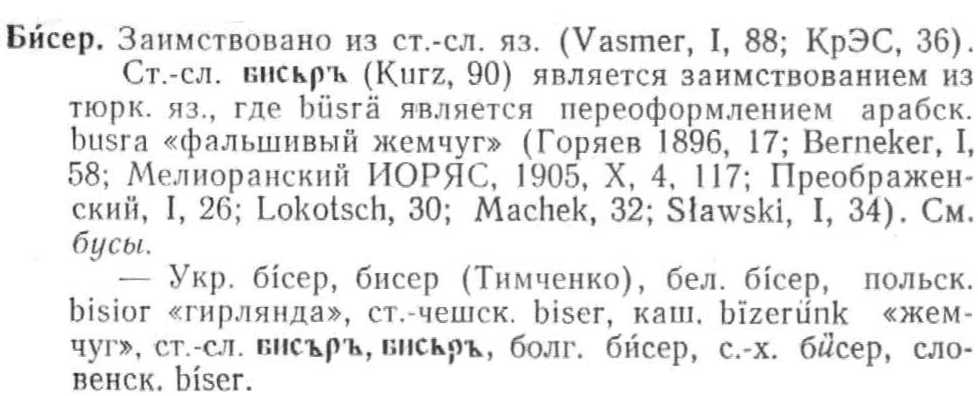
Grammars
Grammars often appear in library catalogs with subject headings such as Grammar–Russian language. Specialized grammars sometimes further delineate this subject headings with additional terms such as “History” or “Comparative.” Try some of these headings in WorldCat or in your online catalog to find other Russian grammars. For an annotated bibliography of Slavic grammars and dictionaries published before 1850, see Stankiewicz which is described in the Sources for Dictionaries and Language Resources section of this course. Many Russian titles are included in this work. For ones published prior to 1872 see Literatura izsliedovanii o tserkovnoslavianskom i russkom iazykakh na inostrannykh iazykakh: s XVI vieka po 1872 god… which is glossed on the page for CS/OCS. Below we cite only two standard reference grammars out of the many grammars that exist for Russian, the Academy grammar and a reference grammar in English. Also included in this category are orthographic manuals and we describe a fairly recent one for Russian to give you an idea of what they contain.
Russkaia grammatika.
Akademiia Nauk SSSR. Moskva: Izd-vo Nauka, 1982. 2 vols.
U of I Library Call Number: International & Area Studies Russian Reference (Slavic) 491.75 R9213 1982 v.1-2
Produced by scholars at the Institut russkogo iazyka, the Academy grammar is the standard reference grammar for the contemporary Russian literary language. It is both descriptive and normative. Sections present phonetics, phonology, stress, intonation, morphemics, word-formation, morphology, and syntax. Individual topics are described and examples are given. In addition, there are numerous cross references to other sections and literary passages to show usage. At the end of each volume is a list of sources, a subject index, and a detailed table of contents. At the end of volume 1, which contains the sections on morphology, there is an index of morphemes. See the excerpt on the left from volume 1, p.506, which begins a discussion of non-declinable nouns in Russian.

A Comprehensive Russian Grammar.
Wade, Terence. Oxford: Blackwell, 2000. 2nd ed., revised and expanded. 596 p.
U of I Library Call Number: International & Area Studies Russian Reference (Slavic) and Main Stacks 491.75 W117c 2000
This English-language reference grammar is very popular, having been reprinted many times before a second, revised edition was published. It presents topics in Russian grammar in an accessible manner with handy tables and examples printed in bold face. At the end there are a glossary of terms, a bibliography, a subject index and a word index. There is also a very detailed table of contents. The grammar topics are arranged by part of speech plus an introduction which covers pronunciation and orthography and a section on word order.

Russkoe pravopisanie. Orfograficheskii spravochnik. Slovar’, kommentarii, pravila.
Solov’ev, N.V. Sankt-Peterburg: Norint, 1997. 2-e izd., isprav. i dopol. 845 p.
U of I Library Call Number: International & Area Studies Russian Reference (Slavic) 491.781003 So478r1997
An orthographic manual elucidates the rules of orthography ( pravopisanie in Russian) for a particular language. These include spelling, punctuation, and capitalization, for example. There have been a number of these published for Russian. The one annotated here is the most recent one held in the Russian reference section of our library that was produced by a scholar at the Russian Academy of Sciences. The first part of the book contains a dictionary or lexicon of words that commonly cause difficulties and the second part is the rules. There is a detailed table of contents to help locate specific topics.
There are also orthographic dictionaries for Russian which list thousands of words, but usually do not remark on the rules. To find some of these try using the subject heading Russian language–Orthography and spelling–Dictionaries.
Biographical Sources for Russian Linguistics
Keep in mind that the subject guides for specific disciplines usually have biographical sections. See the biographical section of the printed Russian guide to linguistics, Bibliografiia bibliografii po iazykoznaniiu which is annotated above for more sources in this category. The biographical section on Russian/Soviet academics lists sources that cover scholars and professors from all disciplines including linguistics. For works by Russian linguists from Moscow University see Trudy uchenykh filologicheskogo fakul’teta Moskovskogo universiteta po slavianskomu iazykoznaniiu. Bibliograficheskii ukazatel’.
This section includes mostly biographical dictionaries or sets that are not covered in the Russian biographical archive. Those few that are both in the RBA and included here are of particular signifance and are noted as such. Resources for Russian biography are extremely rich and the Biographical Archive doesn’t even scratch the surface, so be sure to use it as a starting point only.
Vostochnoslavianskie iazykovedy. Biobibliograficheskii slovar’.
M.G. Bulakhov. Minsk: Izd-vo BGU, 1976-1978. 2-e izd. 3 vols.
U of I Library Call Number: International & Area Studies General Slavic Reference (Slavic) 491.80924 B87v vols.1-3
Russian, Ukrainian and Belorussian linguists from the 16th through the 20th centuries are the subject of this biographical dictionary. For inclusion the linguists must have been associated with an educational or scholarly institution in Russia, Ukraine or Belarus, so you will not find an entry for Roman Jakobson, for example, here. The articles in this source are fairly long and include bibliographic references for works by and about the individual linguists. Many of the entries are accompanied by a portrait of the linguist. Entries are arranged alphabetically by surname of the linguist. Volume 1 runs from A to Ia. Volume 2 contains A to K and Volume 3 L to Ia. Each volume has a table of contents which lists each entry as well as a name index which gives access to people mentioned in the various entries. A highlight of this source is the article on that great East Slavic linguist, Vladimir Ilich Lenin, in Volume 3. See the rather short entry on Nikolai Vasilevich Zakrevskii. Most are about twice as long as this one with many that are much longer.

Kto est’ kto v sovremennoi rusistike.
Karaulov, Iurii , Mustajoki, Arto . Moskva-Khel’sinki: Institut russkogo iazyka Rossiiskoi Akademii nauk, 1994. 330 p.
U of I Library Call Number: Oak Street Facility 491.700922 K849
This biographical dictionary provides information about scholars of Russian linguistics around the world who were still living as of 1994. The data for the entries was gathered by sending out surveys, thus some entries will be more complete than others depending on how the individuals filled out their surveys. Also some important scholars are not included at all. Entries may contain birthdates, family information, education, career data, and contact information as well as listings of some major publications. See the entry which appears on page 41 for Mikhail Gapeevich Bulakhov who wrote the dictionary Vostochnoslavianskie iazykovedy described above.
Russkoe i slavianskoe iazykoznanie v Rossii serediny XVIII-XIX vv.
Russkoe i slavianskoe iazykoznanie v Rossii serediny XIX-nachala XX vv.
Smirnov, S. V. ; Safronov, German Ivanovich. ; Dmitriev, Petr Andreevich. Leningrad: Izd-vo Leningradskogo universiteta, 1980 + 1991. 211 p. + 229 p.
U of I Library Call Number: Oak Street Facility 409.22 R9218 + 409.22 Sm17r
Although these two volumes together cover only 12 individuals engaged in the study of Russian or Slavic languages, the articles on each one are extensive. They begin with a biographical sketch and follow with several other pieces which often include memoirs about the figure by people who were close to them. The articles are signed and provide bibliographical references. There are name indexes in both volumes. The figures are Lomonosov, Vostokov, Bodianskii, Preis, Sreznevskii, Grigorovich, Buslaev, Potebnia, Fortunatov, Baudoin de Courtenay, Shakhmatov, and Chernyshevskii.
See also the Spravochnyi vypusk of the Slovar’ russkogo iazyka XI-XVII vv. , for it has biographical entries for all of the contributors to the dictionary.

Subject Websites
 Gramota.ru
Gramota.ru
This portal on the Russian language is sponsored by the Russian Press Ministry and the Obshchestvo liubitelei rossiiskoi slovesnosti and includes a number of members of the Russian Academy of Sciences as its editors. Available here are numerous online dictionaries, news related to the status of the Russian language, book reviews, articles on various topics such as language and politics or language culture, and other resources. There is also a Spravochnoe biuro to which one may submit questions and the answers will be posted online. The site is updated daily.

 Arkhiv Peterburgskoi rusistiki.
Arkhiv Peterburgskoi rusistiki.
URL: http://www.ruthenia.ru/apr/
Created by the Russian Department of the University of St. Petersburg, this site provides current news on various aspects of Russian philology, but with a stronger emphasis on linguistics over literature. In addition, it has a list of links to selected Internet sites related to the topic. For example, it links to free online dictionaries, to the homepages of Russian departments at various Russian universities, and even some online journals. The page entitled “Biblioteka” provides biographies and detailed bibliographies of several important Russian philologists who taught at the University in St. Petersburg. The page entitled “Slovar'” provides long entries written by the members of the Russian Department on various Russian grammatical topics with bibliographical references for further reading.
To find other sites on Russian language and linguistics try using a western search engine such as Google or a Russian one such as Yandex using various key words such as “linguistics” and “portal” or in Russian “iazyk” and “portal.”

![]()
